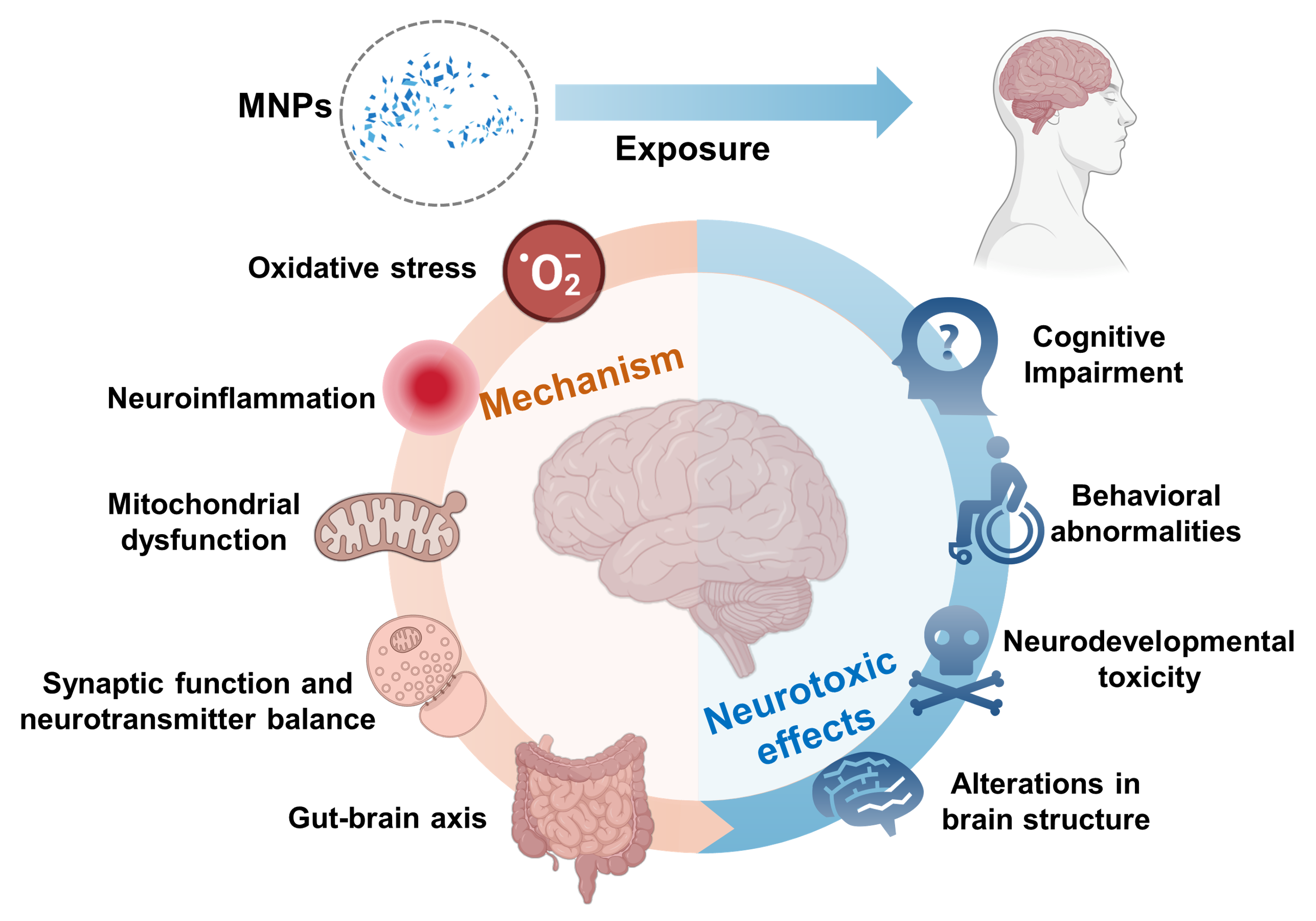 PDF(3739 KB)
PDF(3739 KB)


Neurotoxicity and Mechanisms of Microplastics and Nanoplastics Exposure in Terrestrial Mammals
Yuji Huang, Kailin Xu, Boxuan Liang, Yizhou Zhong, Maoyong Song, Zhenlie Huang
Prog Chem ›› 2025, Vol. 37 ›› Issue (1) : 76-88.
 PDF(3739 KB)
PDF(3739 KB)
 PDF(3739 KB)
PDF(3739 KB)
Neurotoxicity and Mechanisms of Microplastics and Nanoplastics Exposure in Terrestrial Mammals
Microplastics and nanoplastics (MNPs) pollution has become a serious environmental issue. MNPs can enter the human body through inhalation, ingestion, and skin contact, raising significant concerns about their potential risks to the nervous system. This paper reviews the studies on the neurotoxic effects of MNPs in terrestrial mammals, focusing on their possible toxic mechanisms. Studies have shown that MNPs can cause damage to the nervous system by inducing oxidative stress, inflammatory responses, and mitochondrial dysfunction. Additionally, the impact of MNPs on the gut-brain axis is considered a crucial mechanism leading to neurotoxicity. Despite current progress, there are still insufficient data and incomplete understanding of the neurotoxic mechanisms involved. Future research should enhance epidemiological studies on MNP exposure, develop more suitable experimental models, investigate the health effects of different types of MNPs, explore their mechanisms in greater depth, and comprehensively assess various influencing factors. These efforts will provide essential insights for a more thorough understanding of the impact of MNPs on human health.
1 Introduction
2 Human exposure to MNPs
2.1 Routes of human exposure to MNPs
2.2 Detection of MNPs in human tissues and organs
3 Neurotoxic effects of MNPs
3.1 Cognitive impairment
3.2 Behavioral abnormalities
3.3 Neurodevelopmental toxicity
3.4 Alterations in brain structure
3.5 Combined neurotoxic effects of MNPs and other environmental pollutants
4 Mechanisms of toxicity
4.1 Oxidative stress
4.2 Neuroinflammation
4.3 Mitochondrial dysfunction
4.4 Synaptic function and neurotransmitter balance
4.5 Gut-brain axis mechanism
5 Conclusion and outlook

microplastics and nanoplastics / nervous system / mammals / toxic mechanisms
| [1] |
|
| [2] |
|
| [3] |
|
| [4] |
|
| [5] |
(杨壹珺, 王帅兵, 叶长兵, 史应仙, 李雪柔, 原祎昕, 霍佳祺. 环境保护前沿, 2024, 14:51. ).
|
| [6] |
|
| [7] |
|
| [8] |
|
| [9] |
|
| [10] |
|
| [11] |
|
| [12] |
|
| [13] |
|
| [14] |
|
| [15] |
|
| [16] |
|
| [17] |
|
| [18] |
|
| [19] |
|
| [20] |
|
| [21] |
|
| [22] |
|
| [23] |
|
| [24] |
|
| [25] |
|
| [26] |
|
| [27] |
|
| [28] |
|
| [29] |
|
| [30] |
|
| [31] |
|
| [32] |
|
| [33] |
|
| [34] |
|
| [35] |
|
| [36] |
|
| [37] |
|
| [38] |
|
| [39] |
|
| [40] |
|
| [41] |
|
| [42] |
|
| [43] |
|
| [44] |
|
| [45] |
|
| [46] |
|
| [47] |
|
| [48] |
|
| [49] |
|
| [50] |
|
| [51] |
|
| [52] |
|
| [53] |
|
| [54] |
|
| [55] |
|
| [56] |
|
| [57] |
|
| [58] |
|
| [59] |
|
| [60] |
|
| [61] |
|
| [62] |
|
| [63] |
|
| [64] |
|
| [65] |
|
| [66] |
|
| [67] |
|
| [68] |
(张亚萍, 田蕾, 谢晓倩, 王亚婷, 吕鹏, 袭著革. 中国应用生理学杂志, 2022, 38(06):760.)
|
| [69] |
|
| [70] |
|
| [71] |
|
| [72] |
|
| [73] |
|
| [74] |
|
| [75] |
|
| [76] |
|
| [77] |
|
| [78] |
|
| [79] |
|
| [80] |
|
| [81] |
|
| [82] |
|
| [83] |
|
| [84] |
|
| [85] |
|
| [86] |
|
| [87] |
|
| [88] |
|
| [89] |
|
| [90] |
|
| [91] |
|
| [92] |
|
| [93] |
|
| [94] |
|
| [95] |
|
| [96] |
|
| [97] |
|
| [98] |
|
| [99] |
|
| [100] |
|
| [101] |
|
| [102] |
|
| [103] |
|
| [104] |
|
| [105] |
|
| [106] |
|
| [107] |
|
| [108] |
|
| [109] |
|
| [110] |
|
/
| 〈 |
|
〉 |